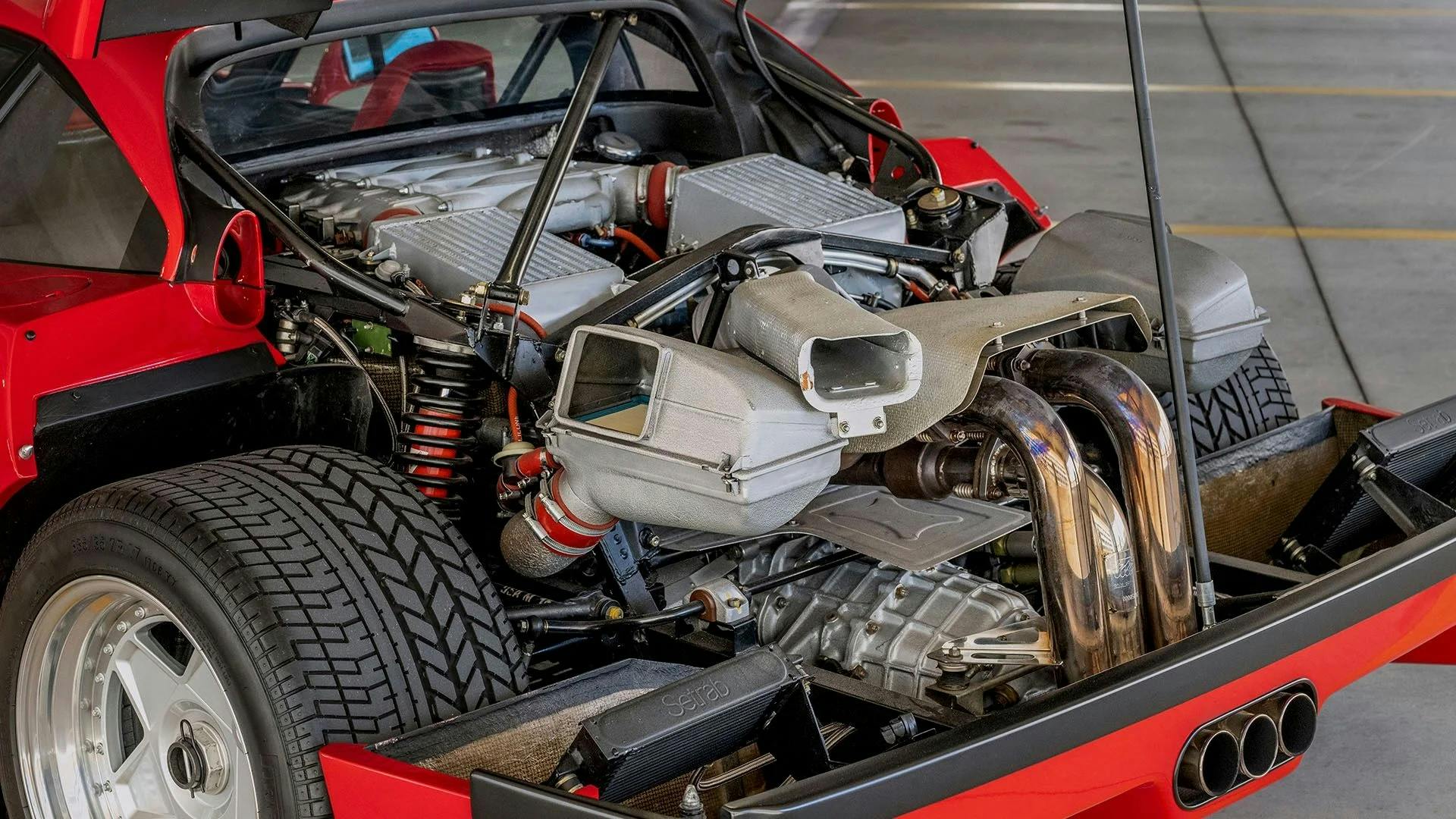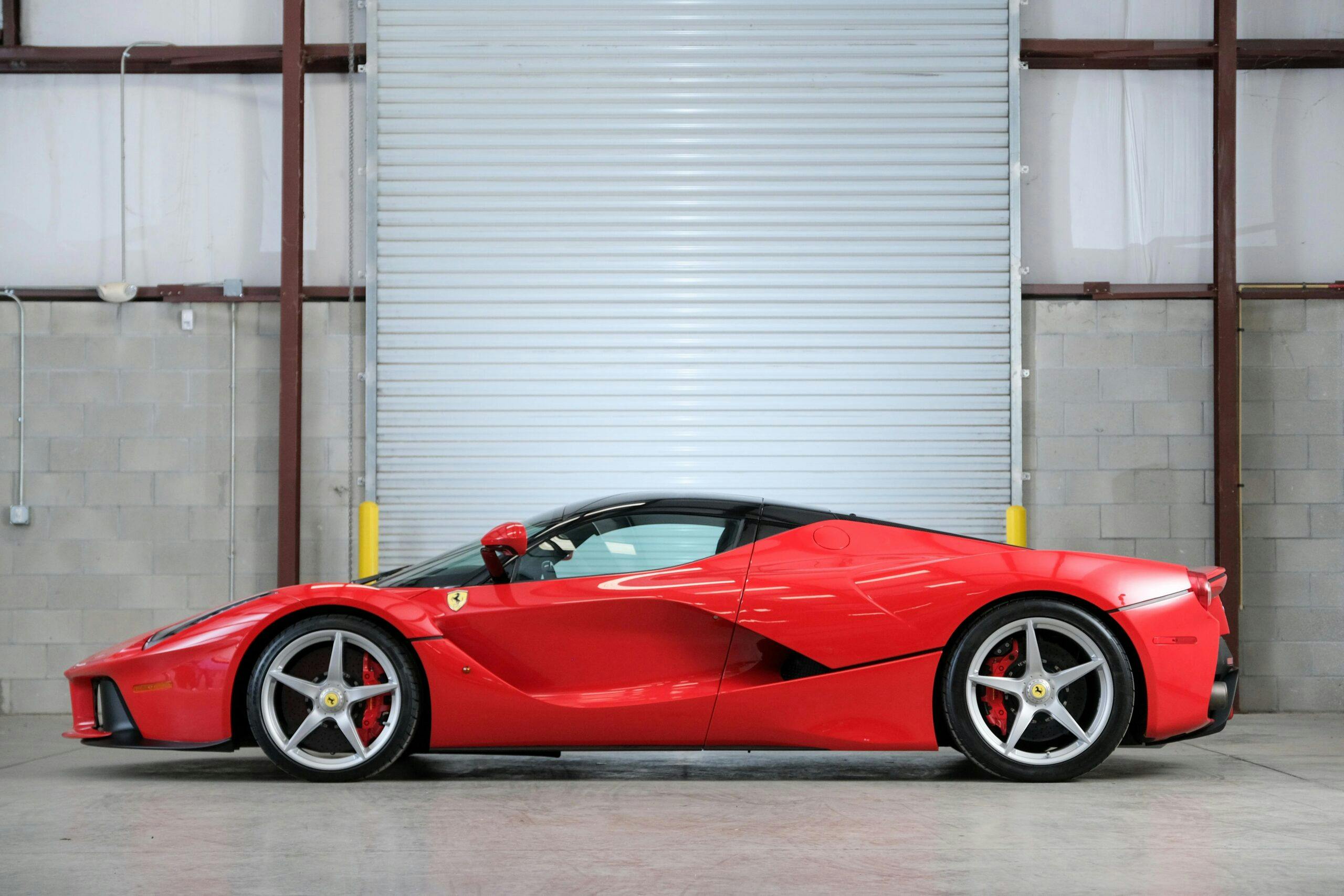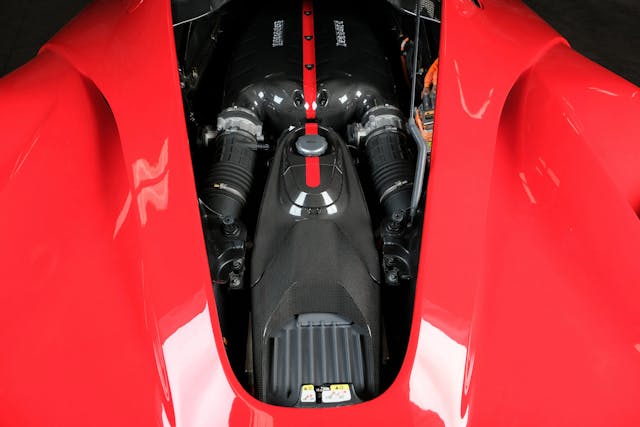5 Ferraris That Paved the Path for the F80
Ferrari’s newest flagship, the F80, has a lot of weight on its proverbial shoulders. When you’re the standard bearer for one of the world’s most exclusive car brands, scrutiny is high. The newest tech, massive power, and a price tag that would make a Malibu real-estate agent blush come with the territory.
The F80 has 1200 horsepower on tap, the most of any Ferrari road car ever. Of that figure, 900 comes from the V-6 engine and its twin e-turbos—turbochargers augmented by electric motors situated between the turbine and compressor housings. That engine uses some of the same components as the 499P, the race car that won the 24 Hours of Le Mans for Ferrari in 2023 and 2024. The other 300 horses are provided by the F80’s hybrid system, which uses the first-ever in-house built electric motors from Ferrari—two on the front axle and one, called the MGU-K bolstering the V-6s power at the rear. As you might guess from the name, Ferrari developed the rear motor using its learnings from its Formula 1 operations. Even the F80’s brakes use special longer fibers of carbon to improve strength and conduct heat more efficiently, and the rotors are coated in silicon carbide, both firsts for a road car.
Why is the F80, which starts at $3.1M, under such pressure to perform? It continues a super-and hypercar legacy dating back nearly 50 years, and its pedigree includes some of the most bleeding-edge cars Ferrari ever made.
Getting road-going technology and engineering from race cars is a theme amongst Ferrari’s flagship supercars. Their efforts over the years has yielded some outstanding numbers, memorable designs, and even a little controversy (just like Ferrari’s choice to put a V-6 in the F80 is doing today). What are the F80’s forebears known for, and where do they stand in the market today? Let’s take a look.
288 GTO

By the mid-1980s, mid-engine halo cars were familiar territory for Ferrari: The 512BB had been around since 1973 and the Testarossa was about to debut in ’84. But the 288 GTO’s introduction at the Geneva Motor Show in 1984 would set Ferrari on its modern supercar trajectory.
The 288 GTO looked similar to its sibling, the 308, but they were very different cars. The GTO’s body panels were constructed using fiberglass, kevlar, and carbon fiber (the doors remained fashioned in steel) and it was longer and wider than the 308. On the inside, the 288 GTO got a roll-over bar like all race cars should. Engineers rotated the V-8 90 degrees so it was now longitudinally mounted, and added two turbochargers to top it all off. It made its 400hp at 7,000 rpm—almost doubling the 308’s power and enough to propel it from zero to 60 mph in just 4.9 seconds.


As a homologation effort for Group B racing production was always going to be extremely limited. Ferrari initially planned to sell just 200, but demand was high enough that it built 272. Concours-condition (#1, in Hagerty Price Guide terminology) examples of the 288 GTO are valued at $4M today, and #2 (excellent) condition cars are up in value 48.9% in the last five years to $3.5M.
F40

The legacy of the GTO brought the F40 to life. Ferrari calls it “an evolution of [their] extreme car philosophy” and the result is arguably one of the most iconic Ferraris of all time. Like the GTO, the F40 delivered a lot of firsts for Ferrari. It was its first production car to breach the 200 mph mark and it was the first Ferrari to use mostly kevlar and carbon fiber for its body construction. And those body panels were enormous—the front clamshell and rear hood were both large single-piece elements.


Acceleration was blistering, going from zero to 60 mph in just 4.1 seconds. The 2.9-liter V-8 produced 478 horsepower at 7,000 rpm—more than ample enough to push the supercar envelope into a new era. The F40 was meant to be a limited-production vehicle with original build plans for just 400 units, but by the time production stopped in 1992, Ferrari had produced 1,315, including 213 for the United States.
With the F40, Ferrari swung for the fences. Its effort paid off, especially for the customers: Despite these high-for-Ferrari production numbers, the F40’s values have skyrocketed in recent years. #1 (concours) condition models are currently valued at $3.45M, with values going up 156 percent in the last five years alone.
F50

For the follow-up to the F40, Ferrari went big. F1 technology was everywhere on the F50, from its monocoque chassis and pushrod suspension to its F1-derived V-12 engine which produced 520 hp at a screaming 8500 rpm. The F50 wasn’t big on creature comforts, though. It had no antilock brakes, no power steering, and no traction control. The big V-12 was mounted directly to the rear bulkhead of the monocoque, where it translated all of its glorious sound and vibrations directly to the cabin. Visceral, yes—comfortable, not as much.


When the F50 launched, Ferrari announced that they were only going to produce 349 units of the F50. Why that strange number? It was one less than they believed they could sell. Ah, the humility of Modena. Unlike the F40, though, production of the F50 stuck to those numbers.
The F50, though, might have flown a little close to the sun. Period reviews criticized the design (it was always going to be hard to follow the F40), the car’s harsh ride, and the fact that it was around at the same time as the world-beating McLaren F1 didn’t help matters. That initial reception hasn’t stopped values from skyrocketing though—likely due in part to the limited production numbers. Values for #2 (excellent) condition examples are up in value 111 percent in the last five years to $4.45M while cream-of-the-crop #1 (concours) condition examples are valued at $5.3M.
Enzo

Carbon fiber was the name of the game with the Enzo, a lightweight supercar with materials and technology carried over from Formula 1 and with more than enough power to give drivers a race car feel. The Enzo was built using carbon fiber and nomex honeycomb weave to construct the monocoque chassis, keeping things as light and as rigid as possible. The Enzo also got carbon ceramic brakes—the Brembo-developed tech had been in use on Ferrari Formula 1 cars for some time, but the Enzo was the first implementation on a Ferrari road car.

The 6.0-liter V-12 that powered the Enzo made 660 horsepower at 7,800 rpm. The paddle-actuated six-speed transmission was capable of changing gears in just 150 milliseconds, facilitating zero-to-60 acceleration in just 3.7 seconds. The Enzo’s top speed was quoted at over 217 miles per hour. Despite being significantly longer and wider than the F50 that preceded it, the Enzo was only 55 lbs heavier (according to Ferrari at least). Enzo values haven’t skyrocketed quite as much as the values of F40s and F50s in recent years—they’re “only” up 50 percent in the last five years—but they’re still seriously valuable. With only 400 units made (fun fact: the last one was gifted to the Pope, then sold for charity), Enzo values have stayed strong. Concours-condition cars come in at $4.85M while #2 (excellent) condition models are valued at $4.45M.
LaFerrari

While some may have poked fun at the LaFerrari’s name-within-a-name when it launched, there was never any doubt about its performance or the innovation it introduced for the Ferrari brand. What was under the body of the LaFerrari signaled a paradigm shift for Ferrari and meant big changes in the automotive world. The LaFerrari was Ferrari’s first use of a hybrid KERS system (also known as HY-KERS, or Kinetic Energy Recovery System) in a road car, and when the hybrid system was combined with the 6.2-liter V-12 it made big numbers.


The combination of that hybrid KERS system with the LaFerrari’s 6.2-liter V-12 yielded 963 horsepower and allowed the car to hit 60 mph in less than three seconds (some tests resulted in times as quick as 2.5 seconds). Ferrari boasts that the LaFerrari beat the Enzo around the Fiorano circuit, their 1.84-mile home testing track, by five seconds—a lifetime on a track that short. Different types of carbon fiber and kevlar were used to make the body rigid, and an dual-clutch transmission was employed to fire off the LaFerrari’s lightning-fast shifts. .

Only 499 LaFerraris were made and values are high, but for certain versions of the LaFerrari, it’s not all an uptick. Base models in Excellent condition have actually gone down 1.3 percent in value in the last half-decade, to $3.8M. The LaFerrari Aperta (open-top) is a different story, with values of #2 condition cars up $31.2 percent over the last five years to $5.05M. Values for Concours condition LaFerrari base and Aperta models are currently $4.4M and $5.8M, respectively.


